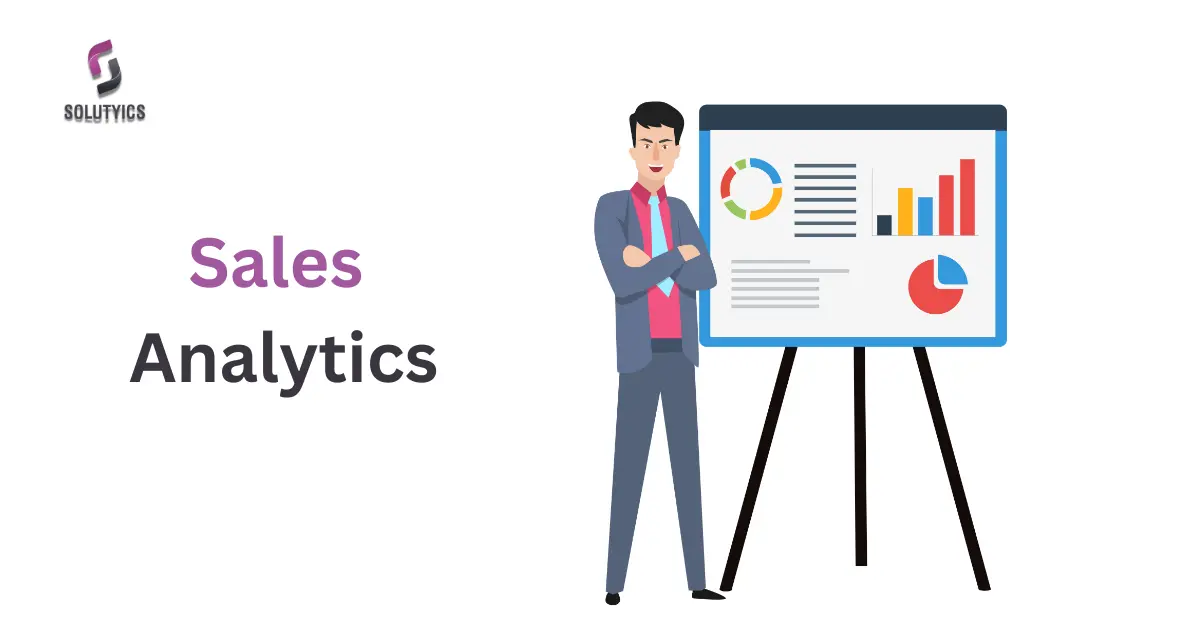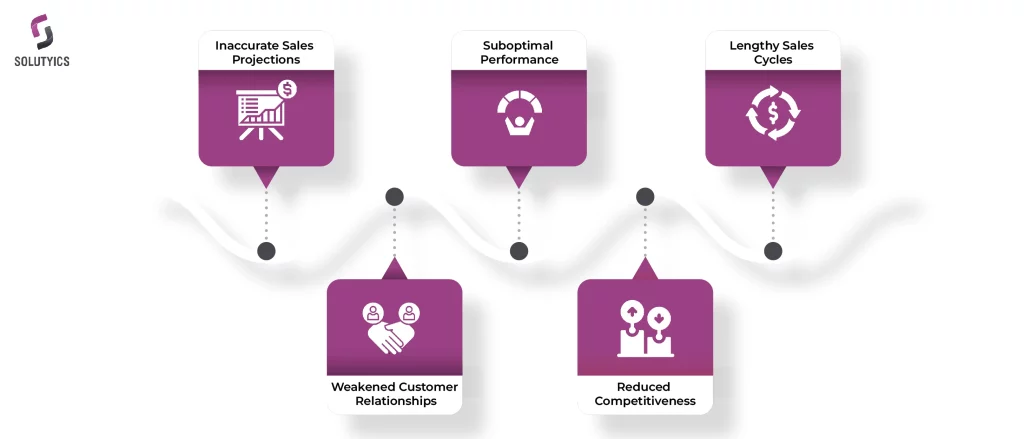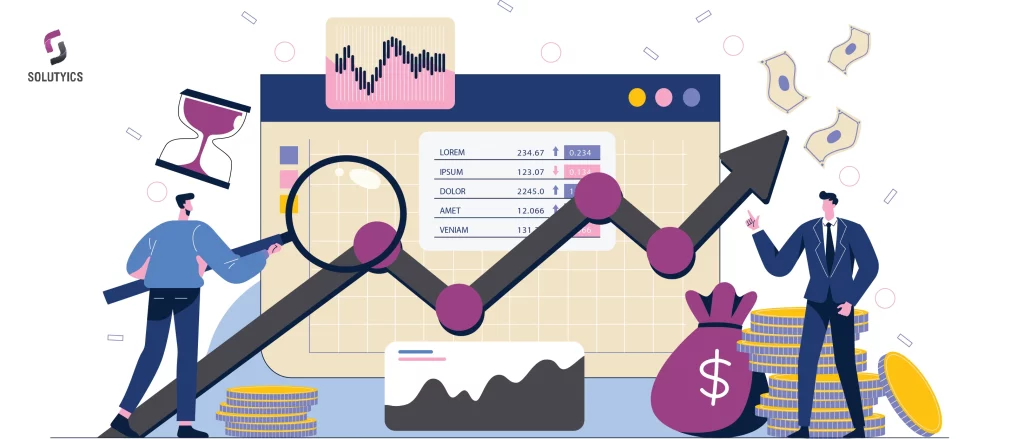
Sales analytics refers to the process of collecting, analyzing, and interpreting data to make informed and strategic business decisions related to sales. It involves the use of various statistical and quantitative techniques to examine sales data and gain insights into customer behavior, sales trends, and performance metrics. Sales analytics can help businesses understand their sales processes, identify opportunities for growth, optimize sales strategies, and improve overall performance.
Key components of sales analytics include:
- Sales forecasting:
Predicting future sales based on historical data and market trends to help businesses make informed decisions about inventory, resources, and overall business planning.
Example:
A clothing retailer utilizes sales forecasting to predict the demand for various apparel items during different seasons. By analyzing historical sales data and considering market trends, the retailer accurately anticipates the popularity of specific clothing lines, enabling them to stock up on popular items and avoid excess inventory for less sought-after products.
- Customer segmentation:
Grouping customers based on various criteria such as demographics, buying behavior, and preferences to tailor sales and marketing strategies to specific customer segments.
Example: An online streaming platform segments its user base based on viewing preferences, age demographics, and geographical locations. By categorizing users into different groups, the platform tailors its content recommendations and marketing campaigns to cater to each segment’s specific interests, thereby enhancing user engagement and retention.
- Sales performance analysis:
Evaluating sales team performance, individual sales rep performance, and the effectiveness of sales strategies to identify areas for improvement and optimize sales processes.
Example: A pharmaceutical company evaluates its sales team’s performance metrics, such as the number of successful client conversions, average deal sizes, and customer satisfaction rates. By identifying top-performing sales representatives and areas for improvement, the company can provide targeted training programs and incentives to enhance overall sales team productivity and performance.
- Pipeline analysis:
Monitoring and analyzing the sales pipeline to understand the status of different sales opportunities, identify potential bottlenecks, and make adjustments to improve sales efficiency and effectiveness.
Example: A software company monitors its sales pipeline to identify potential bottlenecks in the sales process. By analyzing the progression of leads and opportunities through the pipeline, the company can pinpoint stages where prospects tend to drop off and implement strategies to streamline the sales cycle, ultimately increasing the conversion rate and accelerating sales growth.
- Sales trend analysis:
Identifying patterns and trends in sales data over time to understand market dynamics, customer preferences, and the impact of external factors on sales performance.
Example: An electronics manufacturer conducts sales trend analysis to identify shifting consumer preferences and market dynamics. By analyzing sales data over time, the company recognizes the growing demand for wireless technology and invests in the development of new wireless products, positioning itself to meet evolving consumer needs and gain a competitive edge in the market.
- Customer relationship management (CRM) analysis:
Analyzing data from CRM systems to understand customer interactions, preferences, and behaviors, and using this information to improve customer satisfaction and retention.
Example: A telecommunications company uses CRM analysis to understand customer interactions and preferences. By examining customer data, including call logs and service inquiries, the company identifies common customer pain points and uses this information to enhance customer service protocols, resulting in improved customer satisfaction and increased customer retention rates.
Steps to implement Sales Analytics
Implementing sales predictive analytics involves several key steps and considerations to ensure effective deployment and utilization within an organization. Here’s a general guide on how to implement sales predictive analytics, along with some information on potential costs and software options:
- Define Objectives:
Clearly define the specific objectives and goals you aim to achieve through sales predictive analytics. Whether it’s improving sales forecasting accuracy, identifying potential leads, or optimizing sales strategies, having a clear set of objectives is crucial for a successful implementation.
- Data Collection and Integration:
Gather relevant data from various sources, including CRM systems, sales databases, customer interactions, and external market data. Ensure that the data is clean, organized, and integrated into a centralized data repository to facilitate efficient analysis.
- Data Analysis and Modeling:
Utilize advanced analytics techniques such as machine learning algorithms, regression analysis, and data mining to identify patterns, correlations, and trends within the data. Build predictive models that can forecast sales trends, customer behavior, and potential business opportunities.
- Implementation of Predictive Models:
Integrate the developed predictive models into your existing sales processes and systems. This may involve incorporating the predictive insights into CRM platforms, sales management tools, or other relevant software solutions to support real-time decision-making and sales strategy execution.
- Training and Adoption:
Provide training and guidance to sales teams and relevant stakeholders on how to interpret and utilize the predictive insights effectively. Encourage adoption and integration of predictive analytics into daily sales activities to drive data-driven decision-making and improve overall sales performance.
Costs of Implementing Sales Analytics:
The cost of implementing sales analytics can vary widely depending on several factors such as the size of the business, the complexity of the analytics solution, the technology used, and the specific requirements of the organization. Here are some factors to consider:
- Software and Tools:
The cost of analytics software or tools can range from free (open-source solutions) to high-end enterprise solutions that can be quite expensive. Some popular analytics tools include Salesforce, Tableau, Power BI, and Google Analytics.
- Data Integration:
If your sales data is scattered across different systems and databases, integrating this data can be a significant cost. This includes the cost of middleware, connectors, and possibly hiring specialists for data integration.
- Customization:
If you need a customized solution tailored to your specific business needs, development costs may increase. Custom dashboards, reports, and features can add to the overall expense.
- Training and Support:
Training your team to use the new analytics tools and providing ongoing support can incur additional costs. This is essential for ensuring that your team can effectively utilize the analytics platform.
- Infrastructure:
Consider the cost of the required infrastructure, especially if you are implementing on-premises solutions. Cloud-based solutions might have subscription-based pricing, which could include infrastructure costs.
- Data Quality and Cleansing:
Ensuring the quality and cleanliness of your data is crucial for accurate analytics. Data cleansing tools and processes may add to the overall cost.
- Consulting Services:
If you require external expertise for implementation, consulting services may be necessary. This could involve hiring a third-party consultant or engaging with the analytics tool provider for professional services.
- Licensing and Subscription Fees:
Many analytics tools operate on a subscription or licensing model. Consider the recurring costs associated with these fees.
- Scalability:
If your business is expected to grow, scalability should be factored into the cost. Ensure that the chosen solution can scale along with your business needs.
- Security and Compliance:
If your industry has specific security or compliance requirements, additional costs may be incurred to ensure that your analytics solution meets these standards.
It’s advisable to work closely with your IT and finance teams to conduct a thorough analysis of your organization’s requirements and budget constraints. Additionally, reaching out to vendors for quotes and exploring different pricing models can help in estimating the overall cost of implementing sales analytics for your specific situation.
Software Packages for Sales Predictive Analytics:
There are several powerful software tools for sales analytics, each offering unique features and capabilities. The choice of software depends on the specific needs and preferences of your business. Here are some of the top sales analytics software tools as of my last knowledge update in January 2022:
- Salesforce Analytics Cloud (Tableau):
Salesforce’s Tableau is a widely used analytics platform that allows users to visualize and understand data. It provides robust features for sales analytics, helping businesses gain insights into their sales performance.
- Microsoft Power BI:
Power BI is a business analytics tool by Microsoft that provides interactive visualizations and business intelligence capabilities with a focus on self-service analytics. It integrates well with other Microsoft products and is known for its user-friendly interface.
- Google Analytics:
Google Analytics is a web analytics service that provides insights into website traffic and user behavior. For businesses with an online presence, it can be a valuable tool for understanding customer interactions and optimizing the sales process.
- InsightSquared:
InsightSquared is a sales performance analytics solution designed to improve the productivity and effectiveness of sales teams. It offers features such as sales forecasting, activity tracking, and pipeline management.
- Zoho Analytics:
Zoho Analytics is a self-service business intelligence and analytics platform that allows users to create dashboards and reports. It integrates with various data sources, making it suitable for sales analytics.
- Looker:
Looker is a data platform that provides tools for exploring and analyzing data. It can be used for sales analytics to uncover insights and trends within sales data.
- Sisense:
Sisense is a business intelligence platform that enables users to prepare, analyze, and visualize complex datasets. It is known for its scalability and ease of use.
- Domo:
Domo is a cloud-based business intelligence and analytics platform that offers real-time data visualization and collaboration tools. It can be used for sales analytics to track performance metrics.
- Clari:
Clari is a revenue operations platform that includes features for forecasting, pipeline management, and deal execution. It aims to provide visibility and insights into the entire revenue process.
- QlikView/Qlik Sense:
QlikView and Qlik Sense are business intelligence and data visualization platforms. They allow users to explore and visualize data for better decision-making, including sales analytics.
When choosing a sales analytics software, it’s important to consider factors such as ease of use, integration capabilities, scalability, and the specific analytics features that align with your business objectives.

Disadvantages for firms that choose not to adopt such practices:
Firms that choose not to adopt such practices may face several disadvantages in the future. These could include:
- Inaccurate Sales Projections:
Without sales analytics, businesses may struggle to accurately predict future sales trends, leading to challenges in inventory management, resource planning, and meeting customer demands.
- Ineffective Marketing Strategies:
Without customer segmentation and targeted marketing strategies based on data analysis, firms may fail to effectively reach their target audience, resulting in wasted marketing resources and lower conversion rates.
- Suboptimal Sales Performance:
The absence of sales analytics may lead to an inability to identify and address underperforming areas within the sales process, hindering the overall sales team’s performance and productivity.
- Lengthy Sales Cycles:
Without proper analysis of the sales pipeline, businesses may experience prolonged sales cycles, missed opportunities, and a decrease in the overall efficiency of the sales process, potentially leading to lost revenue and increased costs.
- Inability to Anticipate Market Trends:
Firms that do not utilize sales trend analysis may struggle to anticipate changing market dynamics and consumer preferences, leading to an inability to adapt quickly to market shifts and potentially losing out to more agile competitors.
- Weakened Customer Relationships:
Lack of customer relationship management analysis may result in a failure to understand and address customer needs, leading to reduced customer satisfaction, diminished customer loyalty, and increased customer churn rates.
- Reduced Competitiveness:
Over time, the lack of data-driven decision-making and strategic planning may lead to decreased competitiveness within the industry, making it challenging for businesses to keep up with evolving market demands and consumer expectations.
- Missed Opportunities for Innovation:
Without the insights gained from sales analytics, firms may miss out on opportunities for product innovation and development, hindering their ability to stay ahead of industry trends and meet changing customer preferences.
Overall, the absence of sales analytics in the future can significantly impede a firm’s ability to adapt to market changes, optimize sales processes, and meet evolving customer needs, ultimately impacting its long-term growth and sustainability.
Real-world examples of companies
- Amazon
Amazon uses sales analytics to track the performance of its products and services, identify trends, and make better decisions about inventory, pricing, and marketing. This has helped Amazon to become one of the most successful retailers in the world.
- Netflix
Netflix uses sales analytics to track customer viewing habits and preferences. This information is used to develop new content, recommend content to users, and improve the overall user experience. Netflix’s use of sales analytics has helped it to become the leading streaming entertainment service in the world.
- Salesforce
Salesforce uses sales analytics to track the performance of its sales reps, teams, and products. This information is used to identify high-performing reps and teams, and to develop strategies to improve the performance of low-performing reps and teams. Salesforce’s use of sales analytics has helped it to become the leading provider of customer relationship management (CRM) software.
LinkedIn uses sales analytics to track the performance of its sales reps and to identify the most promising leads. This information is used to allocate resources more effectively and to improve the conversion rate of leads. LinkedIn’s use of sales analytics has helped it to become the leading professional networking platform in the world.
- Walmart
Walmart uses sales analytics to track the performance of its stores, products, and promotions. This information is used to improve inventory management, pricing, and marketing campaigns. Walmart’s use of sales analytics has helped it to become the largest retailer in the world.
These are just a few examples of how companies are using sales analytics to improve their performance and profitability. According to McKinsey, 53% of high-performing sales organizations rate themselves as effective users of sales analytics. As the volume and complexity of sales data continues to grow, sales analytics is becoming increasingly important for businesses of all sizes.

Conclusion:
In summary, sales analytics is crucial for businesses to understand their customers, predict future sales, and improve overall performance. By analyzing data, businesses can tailor their strategies to specific customer segments, evaluate sales team performance, and identify potential bottlenecks in the sales process. Moreover, tracking sales trends and analyzing customer interactions can help businesses make informed decisions and build stronger customer relationships. Companies that uses sales analytics effectively, such as Amazon, Netflix, Salesforce, LinkedIn, and Walmart, have seen significant improvements in their sales processes and overall profitability. As the business landscape becomes increasingly competitive, integrating sales analytics has become essential for businesses to stay ahead and meet evolving customer demands.
Have Questions? Contact Us:
For inquiries or more information, feel free to reach out to our team at @solutyics.com
Explore valuable insights in our latest analytics blogs:
Human Capital Analytics:Revolutionizing Workforce Management with Human Capital Analytics. Read more
Trade Analytics: Gain a deeper understanding of successful trade strategies. Read more
Quality Analytics: Elevate your standards with data-driven quality insights. Read more
Banking Analytics: Navigate the finance landscape with precision and foresight. Read more
Cybersecurity Predictive Analytics: Stay ahead in the digital realm with proactive cybersecurity insights. Read more
Empower your business with knowledge. Click the links and stay informed.
FAQs
1.What is the significance of sales forecasting in the context of sales analytics?
Sales forecasting is a critical aspect of sales analytics as it involves predicting future sales based on historical data and market trends. This process helps businesses make informed decisions about inventory, resources, and overall business planning. Accurate sales forecasts enable companies to anticipate demand, optimize stocking strategies, and avoid excess inventory for less popular products.
2. How does customer segmentation contribute to the effectiveness of sales and marketing strategies?
Customer segmentation involves grouping customers based on demographics, buying behavior, and preferences. This strategy allows businesses to tailor sales and marketing approaches to specific customer segments. For instance, an online streaming platform can categorize users by viewing preferences and age demographics, enhancing content recommendations and marketing campaigns to cater to each segment’s interests, thereby boosting user engagement and retention.
3. In what ways does sales performance analysis contribute to improving overall sales team productivity?
Sales performance analysis evaluates individual and team performance, identifying areas for improvement and the effectiveness of sales strategies. For example, a pharmaceutical company can assess metrics like successful client conversions and customer satisfaction rates. This analysis enables targeted training programs and incentives, enhancing overall sales team productivity and performance.
4. How does pipeline analysis help businesses streamline sales processes and improve efficiency?
Pipeline analysis involves monitoring and analyzing the sales pipeline to understand the status of different sales opportunities and identify potential bottlenecks. For instance, a software company can pinpoint stages where prospects tend to drop off, allowing them to implement strategies to streamline the sales cycle, increase conversion rates, and accelerate overall sales growth.
5. Why is sales trend analysis crucial for businesses in adapting to market changes?
Sales trend analysis involves identifying patterns and trends in sales data over time to understand market dynamics, customer preferences, and external factors’ impact on sales performance. For example, an electronics manufacturer can use this analysis to recognize shifting consumer preferences, allowing them to invest in developing new products that meet evolving needs and gain a competitive edge in the market.
Author
Team Solutyics is a dynamic group of Analytics and AI specialists who bring together a rich mix of expertise. Their combined insights ensure that readers gain a deeper understanding of practical applications of Analytics and AI.
